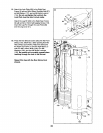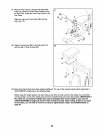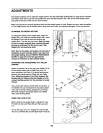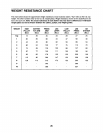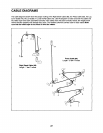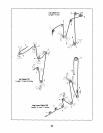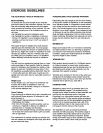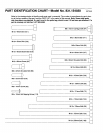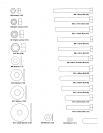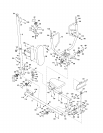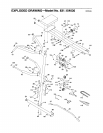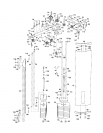
EXERCISE GUIDELINES
THE FOUR BASIC TYPES OF WORKOUTS
Muscle Building
To increase the size and strength of your muscles,
push them close to their maximum capacity.Yourmus-
cleswill continuallyadapt and growas you progres-
sively increasethe intensityof yourexercise. You can
adjust the intensitylevel ofan individualexercise in
two ways:
• by changing the amountof resistanceused
• by changingthe number of repetitionsor sets per-
formed. (A "repetition"isone complete cycleof an
exercise, such as one sit-up. A "set" is a series of
repetitions.)
The proper amountof resistancefor each exercise
depends upon the individualuser.You must gauge
your limitsand selectthe amountof resistancethat is
rightfor you. Begin with 3 setsof 8 repetitionsfor each
exercise you perform. Rest for 3 minutes after each
set. When you can complete3 sets of 12 repetitions
without difficulty,increase the amount of resistance.
Toning
You can tone your muscles by pushingthem to a mod-
erate percentage of theircapacity.Select a moderate
amount of resistanceand increase the numberof rep-
etitionsin each set. Complete as many sets of 15 to
20 repetitionsas possiblewithout discomfort.Rest for
1 minute after each set. Work yourmuscles by com-
pletingmore sets ratherthan by usinghigh amountsof
resistance.
Weight Loss
To lose weight, use a low amount of resistanceand
increasethe number of repetitionsin each set.
Exemise for 20 to 30 minutes,restingfor a maximum
of 30 seconds between sets.
Cross Training
Cross trainingis an efficientway to get a complete and
well-balanced fitness program.An example ofa bal-
anced programis:
• Plan strengthtraining workoutson Monday,
Wednesday, and Fdday.
• Plan 20 to 30 minutesof aerobic exercise, such as
runningon a treadmillor ridingon an ellipticalor
exercise bike, on Tuesday and Thursday.
• Rest from both strengthtrainingand aerobic exercise
for at leastone full day each week to give your body
timeto regenerate.
The combination of strengthtraining and aerobic exer-
cise will reshape and strengthen yourbody, plus devel-
op your heart and lungs.
PERSONALIZING YOUR EXERCISE PROGRAM
Determiningthe exact length of timefor each workout,
as well as the numberof repetitionsor sets completed,
is an individualmatter. It is importantto avoid overdo-
ing itduring the first few monthsof yourexercise pro-
gram. You shouldprogressat your own pace and be
sensitivetoyour body'ssignals. If you expedence pain
or dizziness at any time while exercising,stop immedi-
ately and begin coolingdown. Find out what is wrong
before continuing.Remember that adequate rest and a
properdiet are impodantfactors in any exercise pro-
gram.
WARMING UP
Begin each workoutwith 5 to 10 minutesof stretching
and lightexercise to warm up. Warming up prepares
your bodyfor more strenuousexercise by increasing
circulation,raisingyourbodytemperature and deliver-
ing more oxygen to your muscles.
WORKING OUT
Each workout shouldinclude 6 to 10 differentexercis-
es. Select exercises for every majormuscle group,
emphasizing areas that you want to develop most.To
give balance and variety to your workouts,vary the
exercises from sessionto session.
Schedule your workoutsfor the time of day when your
energy level isthe highest.Each workoutshould be
followedby at least one day of rest. Once you find the
schedule that is rightfor you, stickwith it.
EXERCISE FORM
Maintaining properform is an essential part of an
effectiveexercise program.This requiresmoving
throughthe full range of motionfor each exercise, and
movingonly the appropriateparts of the body.
Exercising in an uncontrolledmannerwill leave you
feeling exhausted. On the exercise guide accompany-
ingthis manualyou willfind photographsshowingthe
correctform for several exercises,and a listofthe
musclesaffected. Refer to the muscle chart on the
next page to find the names ofthe muscles.
The repetitionsin each set shouldbe performed
smoothlyand without pausing.The exertionstage of
each repetitionshouldlast about half as long as the
return stage. Proper breathing isimportant. Exhale
duringthe exertion stage of each repetitionand inhale
duringthe returnstroke. Never hold yourbreath.
3O



